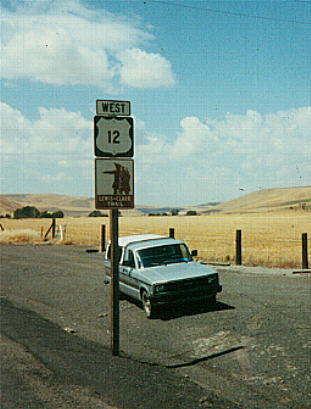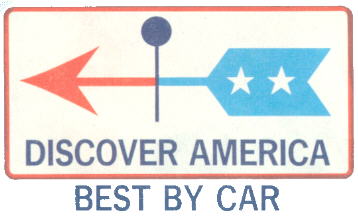U.S. Highway 385 near Granada, CO
So, what's this page all about?
Good question. I'll try to answer as best I can.
For me, and I think for many of postwar generation, The Road has always been a place of possibilities, a place of potential. Adventure, excitement, a break from the dull routine of onerous obligations and mundane responsibilities was always lurking just down The Road.
Growing up in the 60's and 70's, my family would almost always take long vacations across country, in a big station wagon, usually to visit relatives or to see the natural wonders of this magnificent land. Those memories, of long trips, AM radio stations, the smell of a diesel truck or a musty motel-room air conditioner, are some of the fondest memories of my life. But the history of the American road was not just my personal history, it was an important part of the recent history of this country.
The "road culture" that began with the building of the US highway system in the 1920's and '30's (often built as a part of the depression-era Works Project Administration) got its biggest boost after World War II, when millions of Americans, for the first time in their lives, had two things they'd never had before: Free time and disposable income. They used both to traverse this nation far and wide, visiting natural and historic wonders in large numbers, visiting relatives, camping out, and just generally enjoying the freedom they and thier families had fought to achieve.
This 20+ year period, from about 1950 to 1973, can be seen as the "golden era" of automobile travel in America. The full-service gas station, the drive-in movie theater, the franchise restaurant, and the modern motel all trace their ancestry back to this time.

U.S. 12 near Dodge, Washington
In these (mostly) pre-interstate days, highway travel was still something of an adventure. The two-lane US highways usually went through, rather than around, cities both large and small. Interaction with the locals was all but unavoidable, and even though the early days of the franchise restaurant and motel had already begun, there were still plenty of mom-and-pop operations operated along the roads to try and entice passing travelers with huge signs, weird building shapes and yards of neon tubing.
In the days when FM radio stations didn't exist and air conditioning was a luxury few could afford, a traveler really felt a sense of place. Traveling in the midwest? Hog and cattle prices are on the radio, and pungent aroma of the feedlot is in the air. Traveling in the South? The radio announcer greets you with a twangy, honest-to-god regional accent, and hot, sticky air, lush with magnolia and honeysuckle, rolls in through the windows. The radio, the food, the motels, the very air itself -- all of them reflected a distinct regionalism that has all but disappeared from the homogenized, franchised America of today.
Certainly, travel on the Interstates is safe, fast, and convenient. Still, when I think back I can't help but think that we've lost something in the journey to our present day regime of convenience and consistency. It's sad to think that millions of Americans can (and do) travel from coast to coast every year, eating the exact same food at every meal, staying in the same chain-motel, listening to the same top-40 songs spun by DJs with the same generic American accents, windows rolled up tight and air conditioners on, insulated in every possible way from the land through which they are traveling. They might just as well be traveling in a hermetically sealed tube that picks them up at their starting point and deposits them at their destination without ever having to experience the slightest disruption of their daily routine.
This page, then, is dedicated to those two-lane US highways and the vibrant culture they spawned. Follow the links below to find pages of information, history, and reminiscence of the heyday of American highway travel.

Though their Golden Age is long passed, there are still places (and ways) that the adventurous traveler can find to enjoy just a bit of that experience.
Particularly in the American West, it's easy to get at least a little "taste" of that experience by following Timothy Leary's advice to "Turn-off, tune-in and drop-out". That is:
Turn-Off the Air conditioning and roll the window down. Smell that? It's AMERICA, baby, even if it's a feed lot or an oil refinery. ESPECIALLY if it's a feed lot or an oil refinery! Now, Tune-In. That is, pop the CD out, change the radio to an AM station, and start to scan. If you're lucky, (and if you can find something other than political talk-radio) you'll find an "oldies" station, or better still, a small rural station that intersperses music with farm reports, personal "for sale" ads read aloud, and the latest goings-on at the County High school. Finally, and most importantly, drop out. Drop out of the Interstate highway rat-race, jockeying for position with distracted businessmen, caffeine-addled truck drivers and mini-vans filled with glassy-eyed adolescents zombified by the VCR or Nintendo and oblivious to the world whipping by at 75 mph. Take the two-lane road that promises, at least for a little while, respite from the Golden Arches, the Motel 6 and the Mega-Mart convenience store.
It's out there, if you know where to find it. At least for now. Don't miss it, after all, life is a journey, not a destination!
Discovering the 6 , an excellent history of what was, at one time, the longest single highway in America, stretching for 3,500 miles from Cape Cod to Long Beach.
Frank Brusca's Route 40 a site dedicated to a (formerly) cross-country route that can trace its lineage back to the "National Road" first authorized by George Washington!
Coast-to-Coast on U.S. 50, another centrally-located cross-country road that, unlike U.S. 40, has mostly resisted being obliterated by the Interstate. In Nevada, U.S. 50 is called "The Loneliest Road in America".
Exception: The animated graphics (*.gif's) contained on the "Hobbies and Interests" Subject pages. Animated graphics were provided by